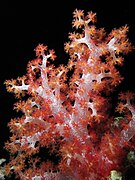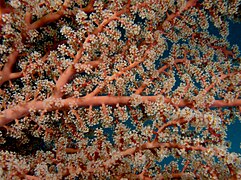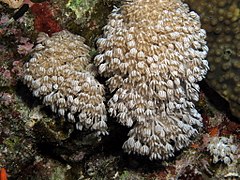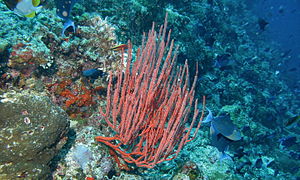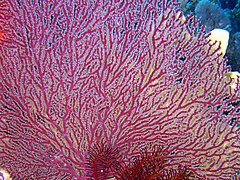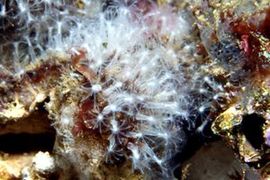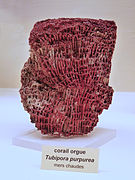Alcyonacea
| Soft coral | |
|---|---|
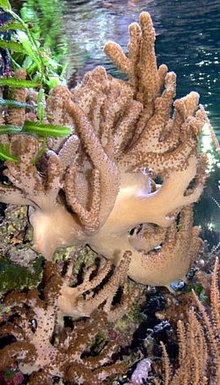
| |
| Cladiella sp. | |
| Scientific classification | |
| Domain: | Eukaryota |
| Kingdom: | Animalia |
| Phylum: | Cnidaria |
| Class: | Octocorallia |
| Order: | Alcyonacea Lamouroux, 1812 [1] |
| Suborders | |
|
See text | |
| Synonyms | |
| |
Alcyonacea, or soft corals, is an order of corals which do not produce calcium carbonate skeletons.
Features

Soft corals contain minute, spiny skeletal elements called sclerites, useful in species identification. Sclerites give these corals some degree of support and give their flesh a spiky, grainy texture that deters predators. In the past soft corals were thought to be unable to lay new foundations for future corals, but recent findings suggest that colonies of the leather-coral genus Sinularia are able to cement sclerites and consolidate them at their base into alcyonarian spiculite,[2] thus making them reef builders.
Unlike stony corals, most soft corals thrive in nutrient-rich waters with less intense light. Almost all use symbiotic photosynthesizing zooxanthella as a major energy source. However, most will readily eat any free floating food, such as zooplankton, out of the water column. They are integral members of the reef ecosystem and provide habitat for fish, snails, algae and a diversity of other marine species.
Despite being dominated by "soft corals", the order Alcyonacea now contains all species known as "gorgonian corals", that produce a more or less hard skeleton, though quite different from "true" corals (Scleractinia). These can be found in suborders Holaxonia, Scleraxonia and Stolonifera.
Many soft corals are easily collected in the wild for the reef aquarium hobby, as small cuttings are less prone to infection or damage during shipping than stony corals. Nevertheless, home-grown specimens tend to be more adaptable to aquarium life and help conserve wild reefs. Soft corals grow quickly in captivity and are easily divided into new individuals, and so those grown via aquaculture are often hardier and less expensive than imported corals from the wild.
Suborders and families
The World Register of Marine Species lists the following suborders and families:[3]
- suborder Alcyoniina
- family Acrophytidae McFadden & Ofwegen, 2017
- family Alcyoniidae Lamouroux, 1812
- family Aquaumbridae Breedy, van Ofwegen & Vargas, 2012
- family Corymbophytidae McFadden & Ofwegen, 2017
- family Leptophytidae McFadden & Ofwegen, 2017
- family Nephtheidae Gray, 1862
- family Nidaliidae Gray, 1869
- family Paralcyoniidae Gray, 1869
- family Xeniidae Ehrenberg, 1828
- suborder Calcaxonia
- family Chrysogorgiidae Verrill, 1883
- family Ellisellidae Gray, 1859
- family Ifalukellidae Bayer, 1955
- family Isididae Lamouroux, 1812
- family Primnoidae Milne Edwards, 1857
- suborder Holaxonia
- family Acanthogorgiidae Gray, 1859
- family Dendrobrachiidae Brook, 1889
- family Gorgoniidae Lamouroux, 1812
- family Keroeididae Kinoshita, 1910
- family Plexauridae Gray, 1859
- suborder Protoalcyonaria
- family Taiaroidae Bayer & Muzik, 1976
- suborder Scleraxonia
- family Anthothelidae Broch, 1916
- family Briareidae Gray, 1859
- family Coralliidae Lamouroux, 1812
- family Melithaeidae Gray, 1870
- family Paragorgiidae Kükenthal, 1916
- family Parisididae Aurivillius, 1931
- family Spongiodermidae Wright & Studer, 1889
- family Subergorgiidae Gray, 1859
- family Victorgorgiidae Moore, Alderslade & Miller, 2017
- suborder Stolonifera
- family Acrossotidae Bourne, 1914
- family Arulidae McFadden & van Ofwegen, 2012
- family Clavulariidae Hickson, 1894
- family Coelogorgiidae Bourne, 1900
- family Cornulariidae Dana, 1846
- family Pseudogorgiidae Utinomi & Harada, 1973
- family Tubiporidae Ehrenberg, 1828
- family Acanthoaxiidae van Ofwegen & McFadden, 2010
- family Haimeidae Wright, 1865
- family Paramuriceidae Bayer, 1956
- family Parasphaerascleridae McFadden & van Ofwegen, 2013
- family Viguieriotidae
-
Iridigorgia sp., a Chrysogorgiidae
-
Ellisella sp., a Ellisellidae
-
Briareum sp., a Briareidae
References
- ^ van Ofwegen, L. (2011). "Alcyonacea Lamouroux, 1812". WoRMS. World Register of Marine Species. Retrieved 15 December 2011.
- ^ Kenji Konishi, "Alcyonarian spiculite: the limestone of soft corals", 1981; M.-S. Jeng, H.-D. Huang, C.-F. Dai, Y.-C. Hsiao and Y. Benayahu. (15 May 2011), "Sclerite calcification and reef-building in the fleshy octocoral genus Sinularia (Octocorallia: Alcyonacea)", Earth and Environmental Science, Coral Reefs doi:10.1007/s00338-011-0765-z.
- ^ "WoRMS - World Register of Marine Species - Alcyonacea". marinespecies.org. Retrieved 22 March 2018.


